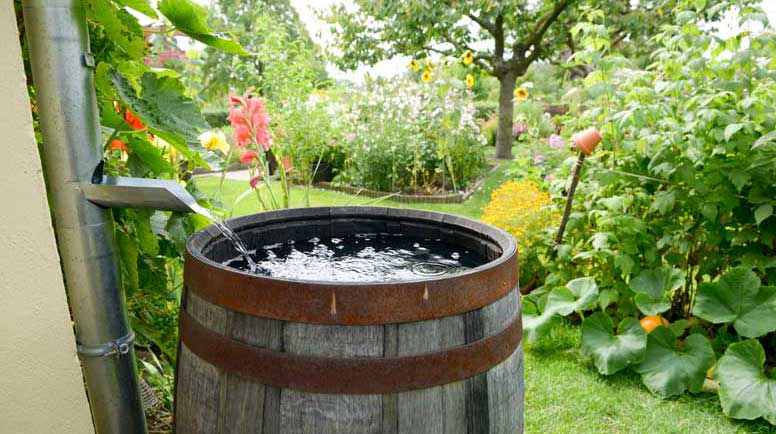Rainwater harvesting is an eco-friendly way to conserve water and reduce your utility bills. By combining a well-maintained gutter system with rain barrels, you can collect and store rainwater to use in your garden or for other non-potable purposes. This simple setup benefits both the environment and your wallet. In this article, we’ll explore how gutters and rain barrels work together, their benefits, and how to set up a rainwater harvesting system.
How Gutters and Rain Barrels Work Together
Gutters collect rainwater from your roof and channel it through downspouts. By attaching a rain barrel to your downspout, you can capture and store this water for later use. The process is straightforward and requires minimal maintenance, making it an accessible solution for most homeowners.
Benefits of Harvesting Rainwater
1. Water Conservation
- Reduce your reliance on municipal water, especially during droughts or dry seasons.
- Provide a sustainable water source for your garden and landscaping.
2. Lower Utility Bills
- Using rainwater for outdoor tasks like watering plants, washing cars, or cleaning patios cuts down on your water expenses.
3. Reduced Stormwater Runoff
- Collecting rainwater minimizes runoff that can carry pollutants into storm drains and local waterways.
4. Healthier Plants
- Rainwater is free of chemicals like chlorine and fluoride, making it better for your plants than treated tap water.
Setting Up a Rainwater Harvesting System
1. Choose the Right Rain Barrel
- Material: Plastic barrels are lightweight and affordable, while metal barrels offer durability.
- Size: A standard rain barrel holds 50–100 gallons, but larger options are available for areas with heavy rainfall.
- Features: Look for barrels with spigots, overflow valves, and screens to keep debris and pests out.
2. Install a Downspout Diverter
A diverter connects your downspout to the rain barrel and directs water into the barrel while filtering out debris.
- How to Install:
- Cut the downspout to the desired height.
- Attach the diverter and secure it with screws.
- Connect the diverter to the rain barrel using the provided hose.
3. Elevate Your Rain Barrel
Placing the barrel on a sturdy platform, such as cinder blocks or a wooden stand, improves water pressure and makes it easier to fill watering cans or connect hoses.
4. Position for Maximum Efficiency
- Place your rain barrel near a garden or area where you’ll use the water most frequently.
- Ensure it’s under a gutter downspout for optimal water collection.
5. Add an Overflow System
To handle excess water during heavy rains, connect an overflow hose to the barrel and direct it to a garden bed, rain garden, or another safe drainage area.
Maintaining Your Rainwater System
- Clean Your Gutters: Regularly remove leaves and debris to ensure water flows freely into the barrel.
- Inspect Filters and Screens: Check for clogs or damage and clean or replace as needed.
- Flush the Barrel: Rinse the barrel periodically to prevent algae growth or sediment buildup.
- Winterize the System: In colder climates, disconnect the barrel and store it indoors during winter to prevent freezing and cracking.
Using Rainwater in Your Garden
1. Watering Plants
Use a hose or watering can to irrigate your garden with stored rainwater. Focus on the base of plants to conserve water and promote healthy root growth.
2. Filling Birdbaths or Ponds
Rainwater is chemical-free and ideal for refilling birdbaths, ponds, or other water features in your yard.
3. Cleaning Outdoor Spaces
Rainwater can be used for washing patios, outdoor furniture, or garden tools.
4. Avoid Drinking Rainwater
Rainwater is not safe for drinking without proper filtration and treatment.
Environmental Impact of Rainwater Harvesting
Rainwater harvesting supports sustainable living by:
- Reducing the strain on municipal water supplies.
- Lowering the risk of flooding and erosion from stormwater runoff.
- Promoting eco-friendly gardening practices.
Rain Barrel Alternatives
If a traditional rain barrel isn’t suitable for your needs, consider these alternatives:
- Rain Tanks: Larger, high-capacity tanks for significant water storage.
- Rain Gardens: Plant-filled basins that absorb and filter rainwater naturally.
- Cisterns: Underground systems for storing large amounts of rainwater.
Conclusion
Rain barrels and gutters make a perfect pair for harvesting rainwater, helping you conserve water, reduce costs, and support sustainable gardening practices. By setting up a rainwater harvesting system and maintaining it regularly, you can make a positive impact on the environment while enjoying the benefits of free, chemical-free water.
Ready to start collecting rainwater? Explore our blog for more eco-friendly tips and ideas for your home and garden!

